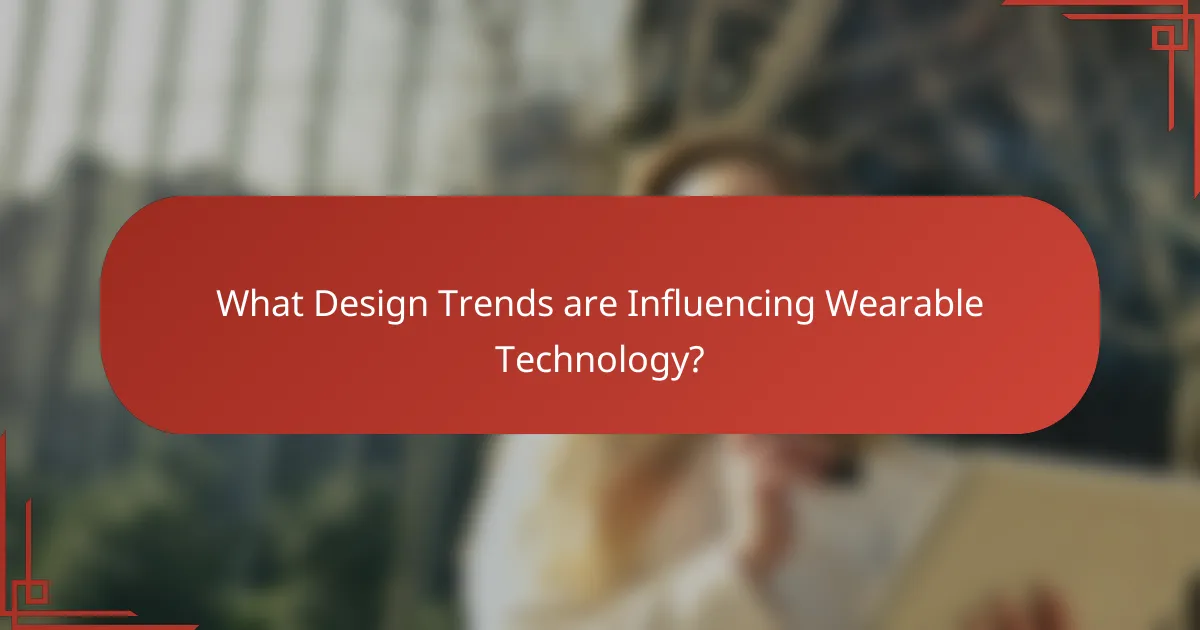Wearable technology encompasses electronic devices designed to be worn on the body, such as smartwatches, fitness trackers, and smart glasses. These devices are equipped with sensors and software to monitor health metrics, track fitness levels, and provide connectivity features. The article explores the transformative impact of wearable technology on health monitoring, highlighting the real-time data it provides for informed health management and remote patient monitoring. Additionally, it examines essential connectivity features like Bluetooth and Wi-Fi, current design trends emphasizing minimalism and personalization, and the growing consumer demand for multifunctional devices. The global market for wearable technology is projected to reach over $60 billion by 2023, reflecting its increasing role in health management and connectivity.

What is Wearable Technology?
Wearable technology refers to electronic devices that can be worn on the body. These devices often track health metrics, monitor fitness levels, or provide connectivity features. Common examples include smartwatches, fitness trackers, and smart glasses. Wearable technology integrates sensors and software to collect data about the user’s physical activity and health status. According to a report by Statista, the global wearable technology market is projected to reach over $60 billion by 2023. This growth underscores the increasing adoption of wearables for health monitoring and connectivity purposes.
How does wearable technology function in everyday life?
Wearable technology functions in everyday life by providing real-time data and connectivity. Devices like smartwatches and fitness trackers monitor health metrics such as heart rate and sleep patterns. They sync with smartphones for notifications and calls, enhancing communication. Wearable devices also promote physical activity through reminders and tracking progress. A study by the Journal of Medical Internet Research found that users of fitness wearables increased their activity levels by an average of 30%. This shows their effectiveness in encouraging healthier habits. Wearable technology integrates seamlessly into daily routines, making health management more accessible.
What are the main types of wearable devices available?
The main types of wearable devices available include smartwatches, fitness trackers, smart glasses, and wearable medical devices. Smartwatches combine traditional watch functions with smartphone connectivity. Fitness trackers monitor physical activities and health metrics like heart rate and steps. Smart glasses provide augmented reality experiences and hands-free information access. Wearable medical devices assist in health monitoring, such as glucose monitors and ECG devices. Each type serves distinct purposes in health monitoring and connectivity.
How do these devices integrate with user activities?
Wearable devices integrate with user activities by tracking health metrics and providing real-time feedback. They monitor heart rate, steps, and sleep patterns, facilitating health management. Users receive notifications for calls, messages, and reminders, enhancing connectivity. Many devices sync with smartphones and apps, allowing data analysis and goal setting. They support activities like exercise by offering coaching and performance metrics. Research shows that 60% of users report improved health awareness through wearables. Integration into daily routines encourages users to maintain active lifestyles and make informed health choices.
What are the primary applications of wearable technology?
The primary applications of wearable technology include health monitoring, fitness tracking, and connectivity. Health monitoring devices track vital signs such as heart rate, blood pressure, and oxygen levels. Fitness trackers measure physical activity, calories burned, and sleep patterns. Wearable technology also enhances connectivity by enabling notifications and communication through smartphones. Examples include smartwatches and fitness bands. According to a report by Grand View Research, the global wearable technology market was valued at $116.2 billion in 2021, highlighting its growing significance.
How does wearable technology enhance health monitoring?
Wearable technology enhances health monitoring by providing real-time data on various health metrics. Devices such as smartwatches and fitness trackers can monitor heart rate, steps taken, and sleep patterns. This continuous tracking allows users to gain insights into their health status. For example, a study published in the Journal of Medical Internet Research found that wearable devices can improve adherence to exercise regimens. Additionally, wearables often sync with mobile applications for easy data analysis. This integration helps users set and achieve health goals more effectively. Furthermore, some devices can alert users to irregular heartbeats or other health issues, enabling timely medical intervention. Overall, wearable technology significantly improves personal health management through accessible and actionable data.
What role does connectivity play in wearable technology?
Connectivity is crucial in wearable technology as it enables real-time data transfer. This allows devices to sync with smartphones and cloud services. Users can receive notifications and access health metrics instantly. Enhanced connectivity improves functionality, such as GPS tracking and remote monitoring. It supports integration with other smart devices, creating a cohesive ecosystem. For instance, wearables can communicate with smart home systems to automate tasks. Studies indicate that over 60% of wearable users value connectivity features. This highlights its importance in enhancing user experience and engagement.

How is Wearable Technology Transforming Health Monitoring?
Wearable technology is transforming health monitoring by providing real-time data on various health metrics. Devices such as smartwatches and fitness trackers can monitor heart rate, sleep patterns, and physical activity. This immediate access to health data allows users to make informed decisions about their well-being. For instance, a study published in the Journal of Medical Internet Research found that users of wearable devices reported improved health management and awareness. Additionally, wearable technology enables remote patient monitoring, reducing the need for frequent doctor visits. According to a report by Grand View Research, the global wearable health technology market is expected to reach $60 billion by 2023. This growth indicates a strong shift towards integrating technology with health management. Wearable devices also facilitate data sharing with healthcare providers, enhancing personalized treatment plans.
What health metrics can wearable devices track?
Wearable devices can track various health metrics. Common metrics include heart rate, which indicates cardiovascular health. They also monitor steps taken, providing insights into physical activity levels. Sleep quality is another metric, helping users understand their rest patterns. Some devices track blood oxygen levels, which can signal respiratory issues. Additionally, wearable devices can measure calorie expenditure, aiding in weight management. Stress levels are monitored through heart rate variability, giving insight into mental health. Some advanced wearables track ECG, providing data on heart rhythm. These metrics collectively help users manage their health effectively.
How accurate are the health metrics provided by these devices?
The accuracy of health metrics provided by wearable devices varies significantly. Many devices claim accuracy rates of 85% to 95% for heart rate monitoring. However, studies show that accuracy can decline during high-intensity activities. For example, a study published in the Journal of Medical Internet Research found that some devices overestimate heart rate by up to 30 beats per minute. Blood oxygen saturation measurements can also be affected by skin tone and ambient light conditions. Overall, while wearable devices offer valuable insights, users should interpret metrics with caution and consider potential inaccuracies.
What are the implications of continuous health monitoring?
Continuous health monitoring can lead to improved health outcomes and proactive care. It enables early detection of health issues, allowing for timely interventions. Studies show that continuous monitoring can reduce hospital admissions by 30%. Patients can manage chronic conditions more effectively with real-time data. This approach fosters a collaborative relationship between patients and healthcare providers. It also empowers individuals to take charge of their health. However, it raises concerns about data privacy and security. Overall, the implications include better health management, increased engagement, and potential ethical challenges.
Why is user engagement crucial in health monitoring?
User engagement is crucial in health monitoring because it directly influences the effectiveness of health interventions. Engaged users are more likely to consistently use health monitoring devices. Regular usage leads to better data collection and more accurate health assessments. Increased engagement also enhances user motivation to adopt healthier behaviors. Studies show that active participation can improve health outcomes significantly. For instance, a report by the American Journal of Preventive Medicine found that users who engaged with health apps achieved greater weight loss compared to non-engaged users. Therefore, fostering user engagement is essential for maximizing the benefits of health monitoring technologies.
How do wearable devices motivate users to maintain health?
Wearable devices motivate users to maintain health by providing real-time feedback on physical activity and health metrics. These devices track steps, heart rate, and sleep patterns. Users receive notifications and reminders to stay active throughout the day. Gamification features, such as challenges and rewards, encourage competition and social interaction. Studies show that users who engage with wearable technology are more likely to meet their fitness goals. For instance, a research study published in the Journal of Medical Internet Research found that wearable devices significantly increased physical activity levels among participants. This evidence supports the effectiveness of wearables in promoting healthier lifestyles.
What features enhance user experience in health monitoring?
User experience in health monitoring is enhanced by features such as real-time data tracking, user-friendly interfaces, and personalized feedback. Real-time data tracking allows users to monitor their health metrics instantly. This feature helps in making timely decisions regarding health management. User-friendly interfaces simplify navigation and interaction with the device. A clear display of information improves usability for all age groups. Personalized feedback provides tailored insights based on individual health data. This customization increases user engagement and motivation. Additionally, integration with mobile applications enhances accessibility and data analysis. These features collectively contribute to a more effective health monitoring experience.

What Connectivity Features are Essential in Wearable Technology?
Essential connectivity features in wearable technology include Bluetooth, Wi-Fi, and cellular connectivity. Bluetooth allows for short-range communication with smartphones and other devices. Wi-Fi enables internet access for data syncing and app updates. Cellular connectivity provides independent communication without needing a paired device. These features enhance functionality and user experience. Research shows that 80% of wearable devices utilize Bluetooth for connectivity. This statistic underscores its importance in the industry.
How do wearable devices connect to other devices?
Wearable devices connect to other devices primarily through Bluetooth technology. Bluetooth allows for wireless communication between devices over short distances. This connection enables wearables to sync data with smartphones, tablets, or computers. For instance, fitness trackers send health data to companion apps on mobile devices. Some wearables also utilize Wi-Fi for broader connectivity, especially for syncing large data sets. NFC (Near Field Communication) is another method, allowing quick pairing with compatible devices. These connection methods facilitate real-time data sharing and notifications. According to a report by Statista, over 50% of wearable device users connect their devices with smartphones.
What technologies enable seamless connectivity?
Technologies that enable seamless connectivity include Wi-Fi, Bluetooth, and cellular networks. Wi-Fi provides high-speed internet access over short distances. It allows devices to connect without physical cables. Bluetooth enables short-range wireless communication between devices. It is commonly used for connecting wearables to smartphones. Cellular networks provide broader coverage for mobile devices. They support data transmission over long distances. Each technology plays a vital role in maintaining continuous connectivity for wearable devices. For instance, Wi-Fi is essential for data-heavy applications. Bluetooth is ideal for low-energy tasks. Cellular networks ensure connectivity when Wi-Fi is unavailable.
How does connectivity enhance the functionality of wearable devices?
Connectivity enhances the functionality of wearable devices by enabling real-time data exchange. This allows wearables to sync with smartphones and other devices for improved user experience. Real-time monitoring of health metrics, such as heart rate and activity levels, becomes possible. Users can receive instant notifications, enhancing engagement with their devices. Connectivity also facilitates cloud storage of health data for long-term tracking. This data can be analyzed for trends and insights, promoting better health management. Furthermore, connectivity supports integration with third-party applications, expanding the device’s capabilities. For instance, wearables can connect to fitness apps, providing personalized workout recommendations. Overall, connectivity significantly broadens the functional scope of wearable devices.
What are the security considerations for connected wearable devices?
Connected wearable devices face several security considerations. These devices often collect sensitive personal data, making them targets for cyberattacks. Data encryption is essential to protect transmitted information. Regular software updates are crucial to patch vulnerabilities. User authentication methods should be robust to prevent unauthorized access. Additionally, privacy policies must be clear and transparent to inform users about data usage. According to a 2021 study by the Ponemon Institute, 60% of organizations reported breaches related to IoT devices, highlighting the need for heightened security measures.
How can users protect their data while using wearable technology?
Users can protect their data while using wearable technology by implementing several key strategies. First, they should enable two-factor authentication for their accounts. This adds an extra layer of security beyond just passwords. Second, users must regularly update their wearable device software. Manufacturers often release updates to patch security vulnerabilities. Third, they should review privacy settings within the device and associated apps. Customizing these settings can limit data sharing. Fourth, users should connect to secure Wi-Fi networks. Public Wi-Fi can expose devices to security risks. Fifth, they must be cautious about the apps they download. Only install apps from trusted sources to reduce malware risks. Lastly, users should monitor the data collected by their devices. Being aware of what data is shared helps maintain privacy. These actions significantly reduce the risk of data breaches and unauthorized access.
What measures do manufacturers take to ensure data security?
Manufacturers implement various measures to ensure data security in wearable technology. They utilize encryption to protect sensitive data during transmission. This prevents unauthorized access to personal information. Regular software updates are conducted to patch vulnerabilities. These updates help mitigate potential security risks. Manufacturers also employ secure authentication methods, such as biometric verification. This ensures that only authorized users can access the device. Additionally, data anonymization techniques are used to protect user identities. These practices comply with regulations like GDPR, enhancing consumer trust. Collectively, these measures create a robust framework for data security in wearable devices.

What Design Trends are Influencing Wearable Technology?
Current design trends influencing wearable technology include minimalism, personalization, and multifunctionality. Minimalism focuses on sleek, unobtrusive designs that enhance user comfort. Personalization allows users to customize their devices, reflecting individual styles and preferences. Multifunctionality integrates various features, such as fitness tracking and communication, into a single device.
These trends are driven by consumer demand for practicality and aesthetic appeal. For instance, a study by McKinsey & Company found that 70% of consumers prefer devices that combine multiple functions. Additionally, advancements in materials have enabled lighter, more durable wearables. This evolution in design enhances user experience and promotes wider adoption of wearable technology.
How are aesthetics impacting the adoption of wearable devices?
Aesthetics significantly impact the adoption of wearable devices. Consumers often prioritize the design and visual appeal of these devices. Research indicates that 70% of users consider aesthetics when selecting wearables. Attractive designs enhance user satisfaction and encourage regular use. Wearable devices that resemble fashion accessories are more likely to be adopted. Brands that integrate style with functionality tend to attract a broader audience. This trend shows that aesthetics play a crucial role in market success and user engagement.
What materials are commonly used in the design of wearables?
Common materials used in the design of wearables include silicone, plastic, metal, and fabric. Silicone is often chosen for its flexibility and comfort. Plastic is lightweight and can be molded into various shapes. Metal, such as aluminum or stainless steel, provides durability and a premium feel. Fabric is used for its breathability and comfort in wearable bands. These materials are selected based on their ability to enhance user experience and functionality. For instance, silicone is waterproof, making it suitable for fitness trackers. Metal components often house sensitive electronics, ensuring protection and longevity. The combination of these materials allows for diverse designs and applications in wearable technology.
How does user comfort influence design choices?
User comfort significantly influences design choices in wearable technology. Designers prioritize ergonomics to ensure devices fit comfortably on the body. A comfortable design enhances user experience and encourages regular use. For instance, materials that are soft and breathable are often selected to prevent skin irritation. Additionally, adjustable features allow for personalized fitting, catering to diverse body types. Research shows that 70% of users prefer wearable devices that do not cause discomfort during extended use. Therefore, user comfort directly impacts the functionality and adoption of wearable technology.
What innovative features are emerging in wearable technology design?
Innovative features emerging in wearable technology design include advanced health monitoring capabilities. These devices now offer real-time biometric tracking, including heart rate variability and oxygen saturation levels. Integration of artificial intelligence enhances predictive health analytics. Flexible and lightweight materials improve comfort and wearability. Solar charging capabilities extend battery life significantly. Enhanced connectivity options facilitate seamless integration with smart home devices. Customizable interfaces allow users to personalize their experience. Lastly, augmented reality features are starting to appear, enhancing user interaction with their environments.
How are customization options enhancing user appeal?
Customization options enhance user appeal by allowing individuals to tailor wearable technology to their personal preferences. This personalization fosters a sense of ownership and connection to the device. Users can select features that align with their lifestyle, such as fitness tracking or health monitoring capabilities. Research indicates that 70% of consumers prefer products that can be customized to their needs. Additionally, customization can improve user satisfaction and engagement, as individuals feel their unique requirements are being met. Brands that offer diverse customization options often see increased customer loyalty and retention. This trend is evident in the growing market for personalized wearables, reflecting a shift towards user-centric design in technology.
What role does user feedback play in design evolution?
User feedback is crucial in design evolution. It informs designers about user needs and preferences. This input leads to improvements in functionality and usability. For instance, wearable technology often adapts based on user experiences. Companies like Fitbit utilize feedback to enhance features and interfaces. Research shows that products designed with user input have higher satisfaction rates. A study by Nielsen Norman Group found that user-centered design increases product success. Thus, user feedback directly influences design iterations and innovation.
What best practices should consumers follow when choosing wearable technology?
Consumers should consider compatibility, features, comfort, battery life, and brand reputation when choosing wearable technology. Compatibility ensures the device works with existing smartphones or systems. Features should align with personal health or fitness goals, such as heart rate monitoring or GPS. Comfort is crucial for daily wear; the device should fit well and not cause irritation. Battery life impacts usability; longer battery life means less frequent charging. Brand reputation can indicate reliability and customer support quality. Research shows that 70% of consumers prioritize compatibility when selecting wearable devices.
Wearable technology refers to electronic devices worn on the body that track health metrics, monitor fitness levels, and provide connectivity features. This article explores the various types of wearable devices, their functionality in daily life, and their applications in health monitoring and connectivity. Key topics include the health metrics tracked by these devices, their accuracy, user engagement, and the essential connectivity features that enhance their functionality. Additionally, the article discusses current design trends, material choices, and best practices for consumers when selecting wearable technology.


